Leadership and Management Development in SES: Recommendations
VerifiedAdded on 2023/01/19
|9
|2863
|32
Report
AI Summary
This report analyzes the leadership and management practices within Space and Engineering Services (SES), highlighting the critical need to distinguish between leaders and managers, emphasizing the importance of visionary leadership, employee motivation, and effective communication. The report identifies a lack of clear vision, poor communication, and inadequate employee engagement as key issues. It recommends transformational leadership approaches, including training managers to create an inspiring vision, motivate employees, and manage change effectively. The report also addresses potential issues arising from interventions, such as resistance to change and financial constraints, and suggests strategies to overcome these challenges, including embracing teamwork and encouraging continuous improvement. Furthermore, it stresses the importance of implementing well-defined hiring and firing procedures to ensure competence and avoid corruption, and concludes that the success of SES hinges on the development of strong leadership and management skills, encompassing behavioral, leadership, communication, and business competencies.
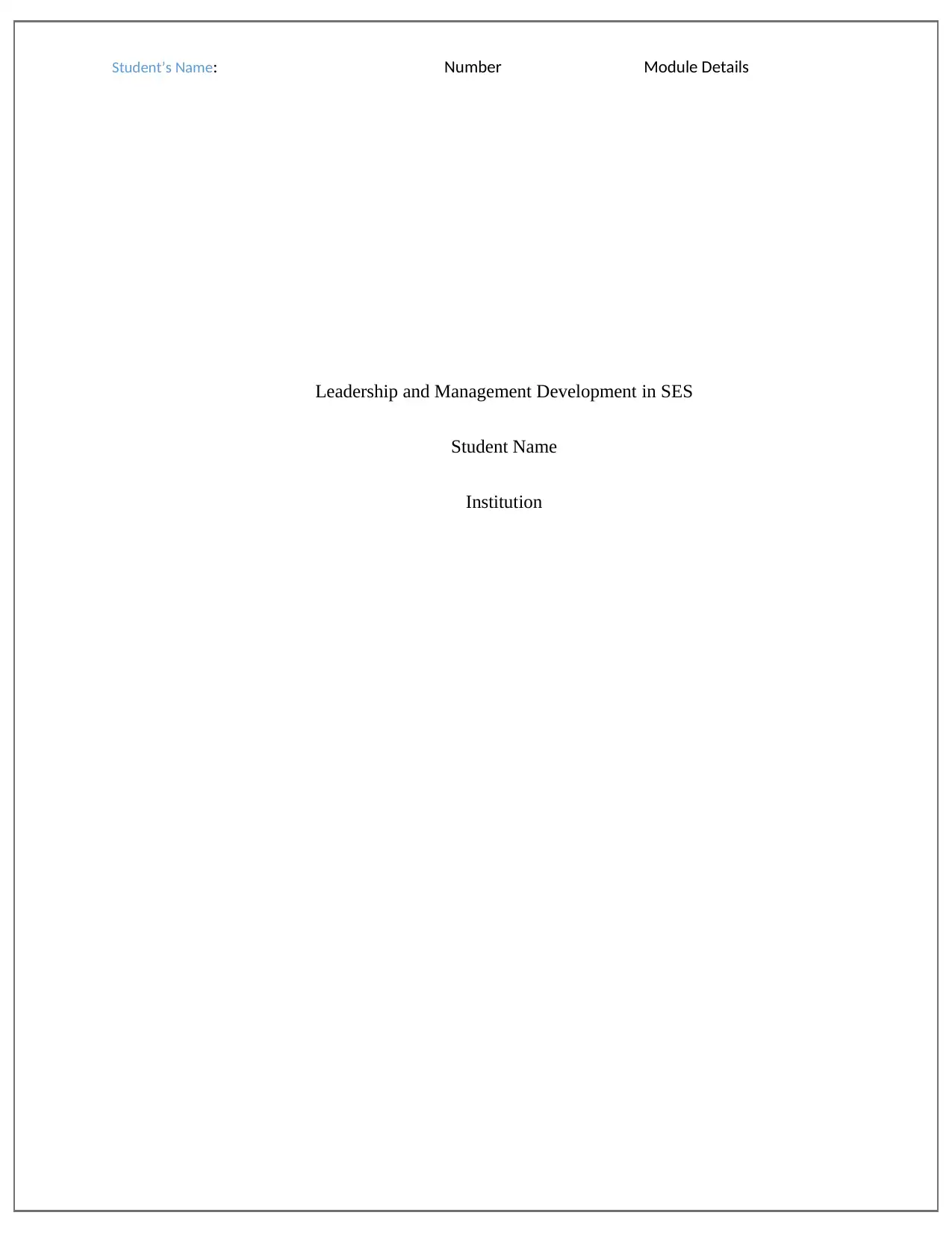
Student’s Name: Number Module Details
Leadership and Management Development in SES
Student Name
Institution
Leadership and Management Development in SES
Student Name
Institution
Paraphrase This Document
Need a fresh take? Get an instant paraphrase of this document with our AI Paraphraser
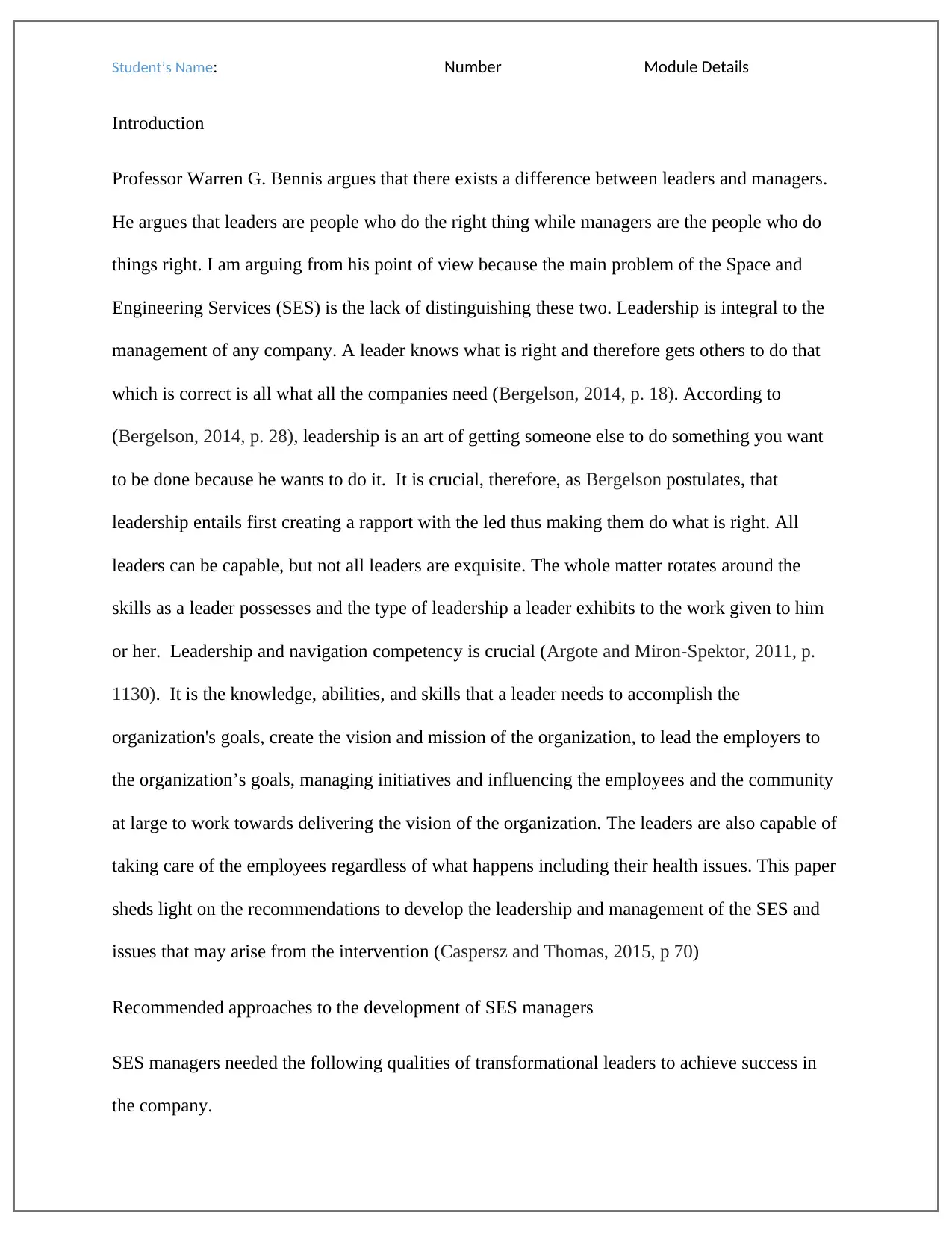
Student’s Name: Number Module Details
Introduction
Professor Warren G. Bennis argues that there exists a difference between leaders and managers.
He argues that leaders are people who do the right thing while managers are the people who do
things right. I am arguing from his point of view because the main problem of the Space and
Engineering Services (SES) is the lack of distinguishing these two. Leadership is integral to the
management of any company. A leader knows what is right and therefore gets others to do that
which is correct is all what all the companies need (Bergelson, 2014, p. 18). According to
(Bergelson, 2014, p. 28), leadership is an art of getting someone else to do something you want
to be done because he wants to do it. It is crucial, therefore, as Bergelson postulates, that
leadership entails first creating a rapport with the led thus making them do what is right. All
leaders can be capable, but not all leaders are exquisite. The whole matter rotates around the
skills as a leader possesses and the type of leadership a leader exhibits to the work given to him
or her. Leadership and navigation competency is crucial (Argote and Miron-Spektor, 2011, p.
1130). It is the knowledge, abilities, and skills that a leader needs to accomplish the
organization's goals, create the vision and mission of the organization, to lead the employers to
the organization’s goals, managing initiatives and influencing the employees and the community
at large to work towards delivering the vision of the organization. The leaders are also capable of
taking care of the employees regardless of what happens including their health issues. This paper
sheds light on the recommendations to develop the leadership and management of the SES and
issues that may arise from the intervention (Caspersz and Thomas, 2015, p 70)
Recommended approaches to the development of SES managers
SES managers needed the following qualities of transformational leaders to achieve success in
the company.
Introduction
Professor Warren G. Bennis argues that there exists a difference between leaders and managers.
He argues that leaders are people who do the right thing while managers are the people who do
things right. I am arguing from his point of view because the main problem of the Space and
Engineering Services (SES) is the lack of distinguishing these two. Leadership is integral to the
management of any company. A leader knows what is right and therefore gets others to do that
which is correct is all what all the companies need (Bergelson, 2014, p. 18). According to
(Bergelson, 2014, p. 28), leadership is an art of getting someone else to do something you want
to be done because he wants to do it. It is crucial, therefore, as Bergelson postulates, that
leadership entails first creating a rapport with the led thus making them do what is right. All
leaders can be capable, but not all leaders are exquisite. The whole matter rotates around the
skills as a leader possesses and the type of leadership a leader exhibits to the work given to him
or her. Leadership and navigation competency is crucial (Argote and Miron-Spektor, 2011, p.
1130). It is the knowledge, abilities, and skills that a leader needs to accomplish the
organization's goals, create the vision and mission of the organization, to lead the employers to
the organization’s goals, managing initiatives and influencing the employees and the community
at large to work towards delivering the vision of the organization. The leaders are also capable of
taking care of the employees regardless of what happens including their health issues. This paper
sheds light on the recommendations to develop the leadership and management of the SES and
issues that may arise from the intervention (Caspersz and Thomas, 2015, p 70)
Recommended approaches to the development of SES managers
SES managers needed the following qualities of transformational leaders to achieve success in
the company.
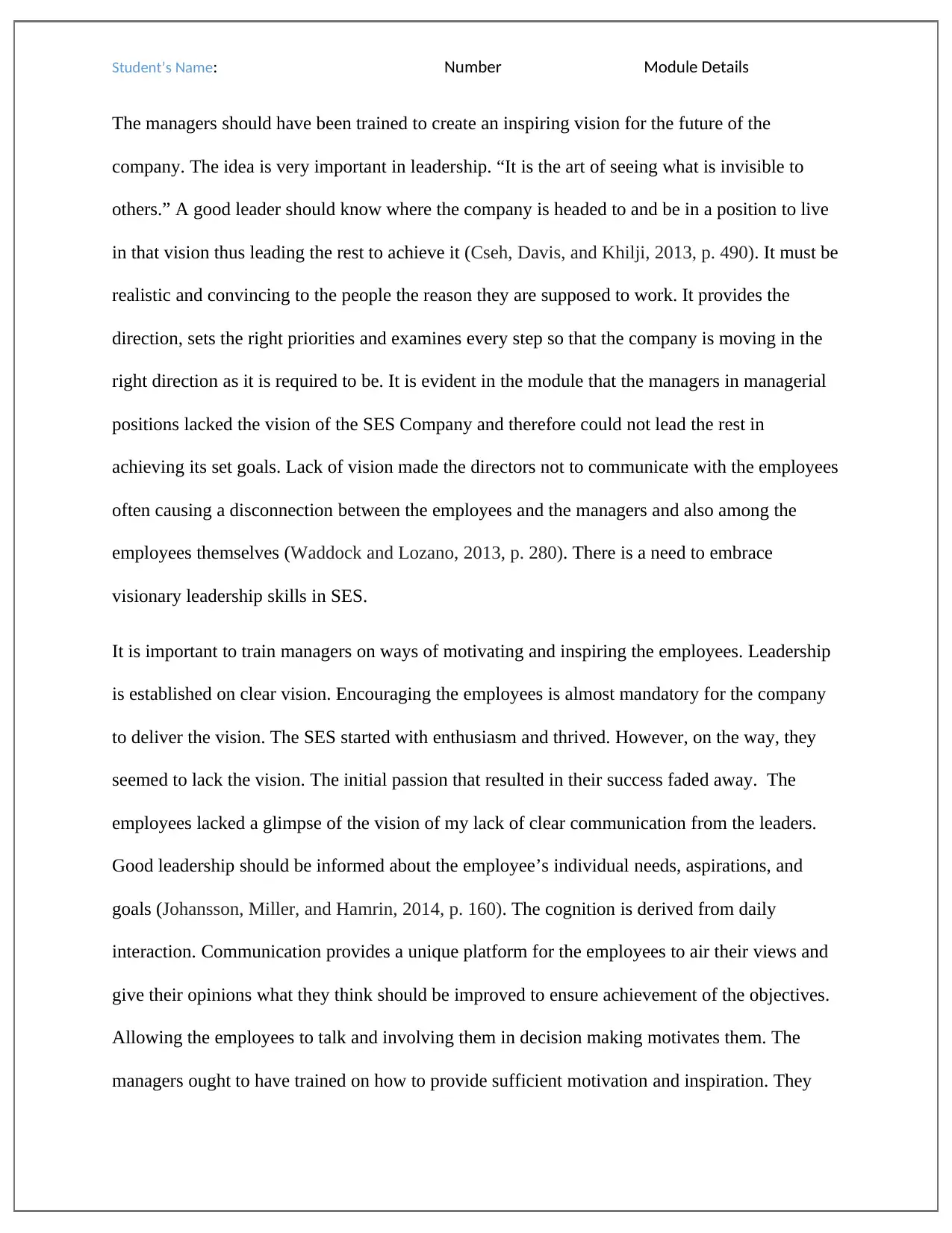
Student’s Name: Number Module Details
The managers should have been trained to create an inspiring vision for the future of the
company. The idea is very important in leadership. “It is the art of seeing what is invisible to
others.” A good leader should know where the company is headed to and be in a position to live
in that vision thus leading the rest to achieve it (Cseh, Davis, and Khilji, 2013, p. 490). It must be
realistic and convincing to the people the reason they are supposed to work. It provides the
direction, sets the right priorities and examines every step so that the company is moving in the
right direction as it is required to be. It is evident in the module that the managers in managerial
positions lacked the vision of the SES Company and therefore could not lead the rest in
achieving its set goals. Lack of vision made the directors not to communicate with the employees
often causing a disconnection between the employees and the managers and also among the
employees themselves (Waddock and Lozano, 2013, p. 280). There is a need to embrace
visionary leadership skills in SES.
It is important to train managers on ways of motivating and inspiring the employees. Leadership
is established on clear vision. Encouraging the employees is almost mandatory for the company
to deliver the vision. The SES started with enthusiasm and thrived. However, on the way, they
seemed to lack the vision. The initial passion that resulted in their success faded away. The
employees lacked a glimpse of the vision of my lack of clear communication from the leaders.
Good leadership should be informed about the employee’s individual needs, aspirations, and
goals (Johansson, Miller, and Hamrin, 2014, p. 160). The cognition is derived from daily
interaction. Communication provides a unique platform for the employees to air their views and
give their opinions what they think should be improved to ensure achievement of the objectives.
Allowing the employees to talk and involving them in decision making motivates them. The
managers ought to have trained on how to provide sufficient motivation and inspiration. They
The managers should have been trained to create an inspiring vision for the future of the
company. The idea is very important in leadership. “It is the art of seeing what is invisible to
others.” A good leader should know where the company is headed to and be in a position to live
in that vision thus leading the rest to achieve it (Cseh, Davis, and Khilji, 2013, p. 490). It must be
realistic and convincing to the people the reason they are supposed to work. It provides the
direction, sets the right priorities and examines every step so that the company is moving in the
right direction as it is required to be. It is evident in the module that the managers in managerial
positions lacked the vision of the SES Company and therefore could not lead the rest in
achieving its set goals. Lack of vision made the directors not to communicate with the employees
often causing a disconnection between the employees and the managers and also among the
employees themselves (Waddock and Lozano, 2013, p. 280). There is a need to embrace
visionary leadership skills in SES.
It is important to train managers on ways of motivating and inspiring the employees. Leadership
is established on clear vision. Encouraging the employees is almost mandatory for the company
to deliver the vision. The SES started with enthusiasm and thrived. However, on the way, they
seemed to lack the vision. The initial passion that resulted in their success faded away. The
employees lacked a glimpse of the vision of my lack of clear communication from the leaders.
Good leadership should be informed about the employee’s individual needs, aspirations, and
goals (Johansson, Miller, and Hamrin, 2014, p. 160). The cognition is derived from daily
interaction. Communication provides a unique platform for the employees to air their views and
give their opinions what they think should be improved to ensure achievement of the objectives.
Allowing the employees to talk and involving them in decision making motivates them. The
managers ought to have trained on how to provide sufficient motivation and inspiration. They
⊘ This is a preview!⊘
Do you want full access?
Subscribe today to unlock all pages.

Trusted by 1+ million students worldwide
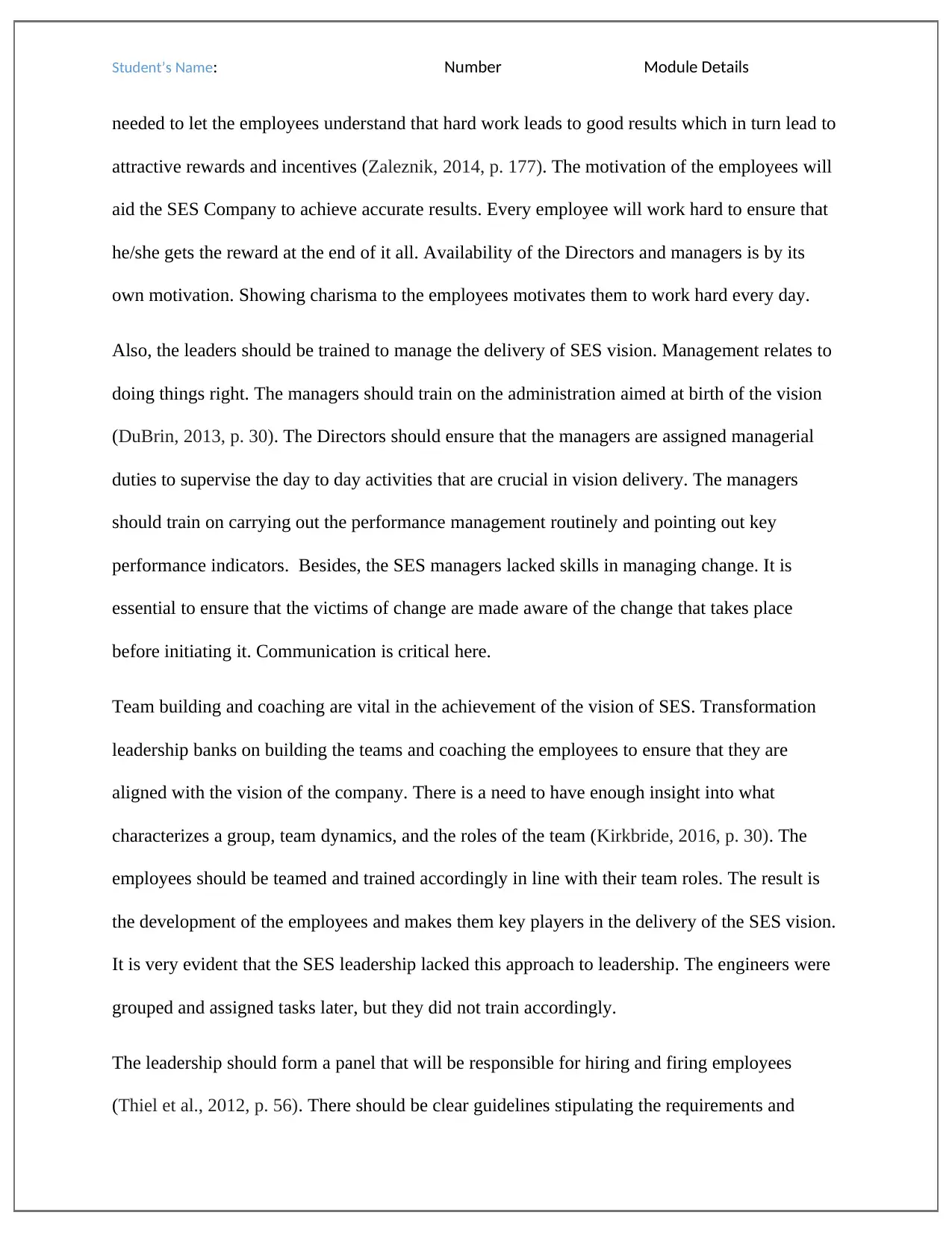
Student’s Name: Number Module Details
needed to let the employees understand that hard work leads to good results which in turn lead to
attractive rewards and incentives (Zaleznik, 2014, p. 177). The motivation of the employees will
aid the SES Company to achieve accurate results. Every employee will work hard to ensure that
he/she gets the reward at the end of it all. Availability of the Directors and managers is by its
own motivation. Showing charisma to the employees motivates them to work hard every day.
Also, the leaders should be trained to manage the delivery of SES vision. Management relates to
doing things right. The managers should train on the administration aimed at birth of the vision
(DuBrin, 2013, p. 30). The Directors should ensure that the managers are assigned managerial
duties to supervise the day to day activities that are crucial in vision delivery. The managers
should train on carrying out the performance management routinely and pointing out key
performance indicators. Besides, the SES managers lacked skills in managing change. It is
essential to ensure that the victims of change are made aware of the change that takes place
before initiating it. Communication is critical here.
Team building and coaching are vital in the achievement of the vision of SES. Transformation
leadership banks on building the teams and coaching the employees to ensure that they are
aligned with the vision of the company. There is a need to have enough insight into what
characterizes a group, team dynamics, and the roles of the team (Kirkbride, 2016, p. 30). The
employees should be teamed and trained accordingly in line with their team roles. The result is
the development of the employees and makes them key players in the delivery of the SES vision.
It is very evident that the SES leadership lacked this approach to leadership. The engineers were
grouped and assigned tasks later, but they did not train accordingly.
The leadership should form a panel that will be responsible for hiring and firing employees
(Thiel et al., 2012, p. 56). There should be clear guidelines stipulating the requirements and
needed to let the employees understand that hard work leads to good results which in turn lead to
attractive rewards and incentives (Zaleznik, 2014, p. 177). The motivation of the employees will
aid the SES Company to achieve accurate results. Every employee will work hard to ensure that
he/she gets the reward at the end of it all. Availability of the Directors and managers is by its
own motivation. Showing charisma to the employees motivates them to work hard every day.
Also, the leaders should be trained to manage the delivery of SES vision. Management relates to
doing things right. The managers should train on the administration aimed at birth of the vision
(DuBrin, 2013, p. 30). The Directors should ensure that the managers are assigned managerial
duties to supervise the day to day activities that are crucial in vision delivery. The managers
should train on carrying out the performance management routinely and pointing out key
performance indicators. Besides, the SES managers lacked skills in managing change. It is
essential to ensure that the victims of change are made aware of the change that takes place
before initiating it. Communication is critical here.
Team building and coaching are vital in the achievement of the vision of SES. Transformation
leadership banks on building the teams and coaching the employees to ensure that they are
aligned with the vision of the company. There is a need to have enough insight into what
characterizes a group, team dynamics, and the roles of the team (Kirkbride, 2016, p. 30). The
employees should be teamed and trained accordingly in line with their team roles. The result is
the development of the employees and makes them key players in the delivery of the SES vision.
It is very evident that the SES leadership lacked this approach to leadership. The engineers were
grouped and assigned tasks later, but they did not train accordingly.
The leadership should form a panel that will be responsible for hiring and firing employees
(Thiel et al., 2012, p. 56). There should be clear guidelines stipulating the requirements and
Paraphrase This Document
Need a fresh take? Get an instant paraphrase of this document with our AI Paraphraser
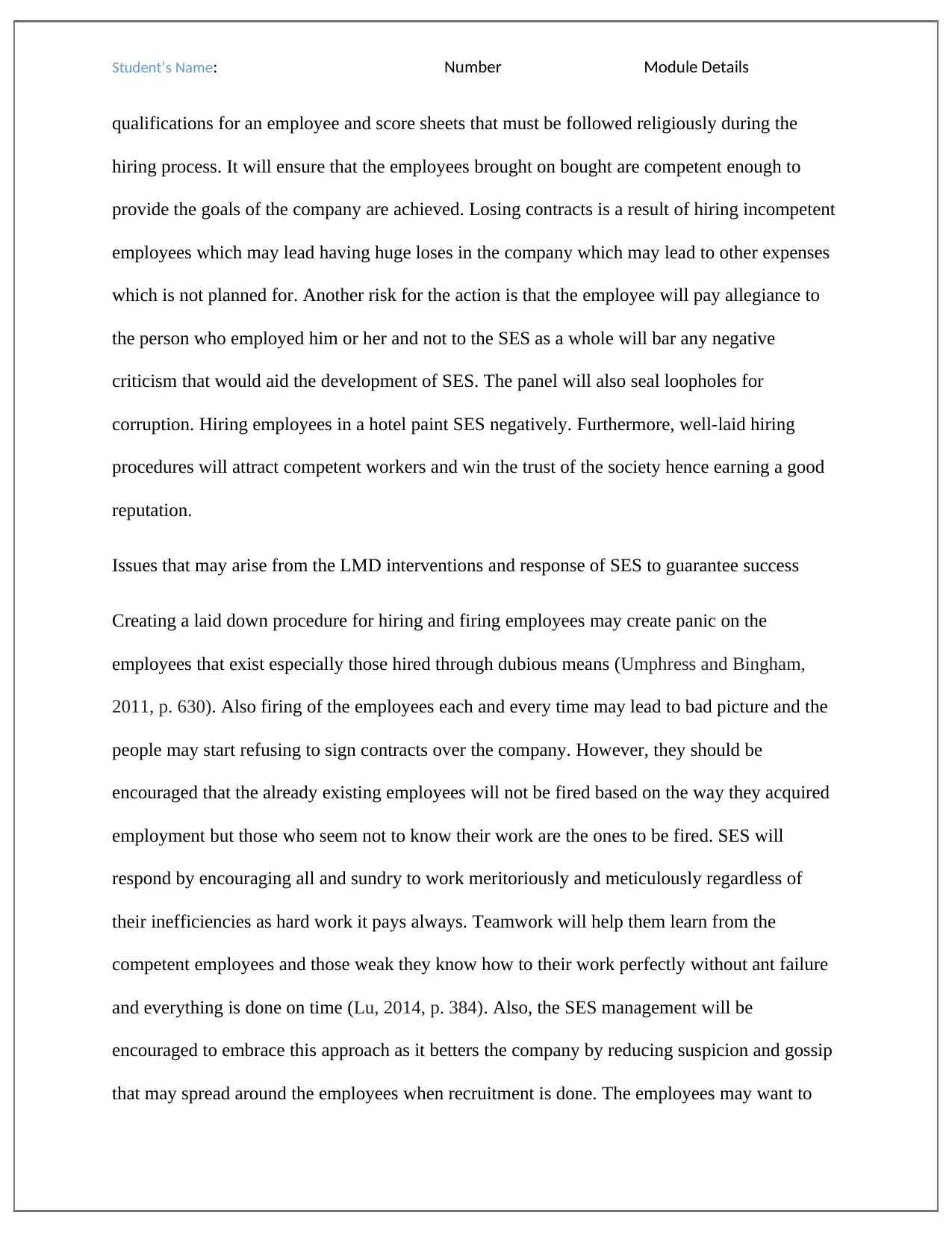
Student’s Name: Number Module Details
qualifications for an employee and score sheets that must be followed religiously during the
hiring process. It will ensure that the employees brought on bought are competent enough to
provide the goals of the company are achieved. Losing contracts is a result of hiring incompetent
employees which may lead having huge loses in the company which may lead to other expenses
which is not planned for. Another risk for the action is that the employee will pay allegiance to
the person who employed him or her and not to the SES as a whole will bar any negative
criticism that would aid the development of SES. The panel will also seal loopholes for
corruption. Hiring employees in a hotel paint SES negatively. Furthermore, well-laid hiring
procedures will attract competent workers and win the trust of the society hence earning a good
reputation.
Issues that may arise from the LMD interventions and response of SES to guarantee success
Creating a laid down procedure for hiring and firing employees may create panic on the
employees that exist especially those hired through dubious means (Umphress and Bingham,
2011, p. 630). Also firing of the employees each and every time may lead to bad picture and the
people may start refusing to sign contracts over the company. However, they should be
encouraged that the already existing employees will not be fired based on the way they acquired
employment but those who seem not to know their work are the ones to be fired. SES will
respond by encouraging all and sundry to work meritoriously and meticulously regardless of
their inefficiencies as hard work it pays always. Teamwork will help them learn from the
competent employees and those weak they know how to their work perfectly without ant failure
and everything is done on time (Lu, 2014, p. 384). Also, the SES management will be
encouraged to embrace this approach as it betters the company by reducing suspicion and gossip
that may spread around the employees when recruitment is done. The employees may want to
qualifications for an employee and score sheets that must be followed religiously during the
hiring process. It will ensure that the employees brought on bought are competent enough to
provide the goals of the company are achieved. Losing contracts is a result of hiring incompetent
employees which may lead having huge loses in the company which may lead to other expenses
which is not planned for. Another risk for the action is that the employee will pay allegiance to
the person who employed him or her and not to the SES as a whole will bar any negative
criticism that would aid the development of SES. The panel will also seal loopholes for
corruption. Hiring employees in a hotel paint SES negatively. Furthermore, well-laid hiring
procedures will attract competent workers and win the trust of the society hence earning a good
reputation.
Issues that may arise from the LMD interventions and response of SES to guarantee success
Creating a laid down procedure for hiring and firing employees may create panic on the
employees that exist especially those hired through dubious means (Umphress and Bingham,
2011, p. 630). Also firing of the employees each and every time may lead to bad picture and the
people may start refusing to sign contracts over the company. However, they should be
encouraged that the already existing employees will not be fired based on the way they acquired
employment but those who seem not to know their work are the ones to be fired. SES will
respond by encouraging all and sundry to work meritoriously and meticulously regardless of
their inefficiencies as hard work it pays always. Teamwork will help them learn from the
competent employees and those weak they know how to their work perfectly without ant failure
and everything is done on time (Lu, 2014, p. 384). Also, the SES management will be
encouraged to embrace this approach as it betters the company by reducing suspicion and gossip
that may spread around the employees when recruitment is done. The employees may want to
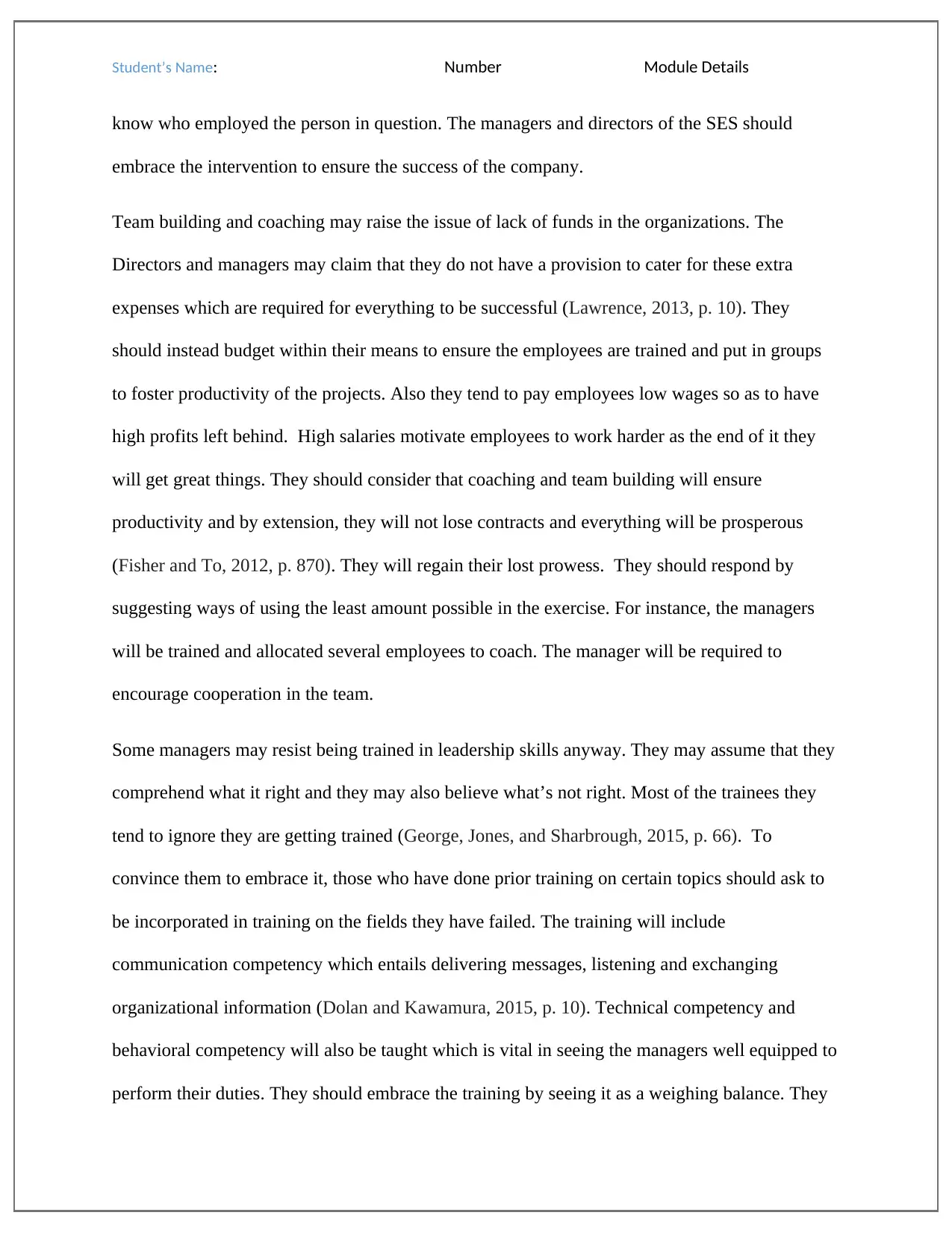
Student’s Name: Number Module Details
know who employed the person in question. The managers and directors of the SES should
embrace the intervention to ensure the success of the company.
Team building and coaching may raise the issue of lack of funds in the organizations. The
Directors and managers may claim that they do not have a provision to cater for these extra
expenses which are required for everything to be successful (Lawrence, 2013, p. 10). They
should instead budget within their means to ensure the employees are trained and put in groups
to foster productivity of the projects. Also they tend to pay employees low wages so as to have
high profits left behind. High salaries motivate employees to work harder as the end of it they
will get great things. They should consider that coaching and team building will ensure
productivity and by extension, they will not lose contracts and everything will be prosperous
(Fisher and To, 2012, p. 870). They will regain their lost prowess. They should respond by
suggesting ways of using the least amount possible in the exercise. For instance, the managers
will be trained and allocated several employees to coach. The manager will be required to
encourage cooperation in the team.
Some managers may resist being trained in leadership skills anyway. They may assume that they
comprehend what it right and they may also believe what’s not right. Most of the trainees they
tend to ignore they are getting trained (George, Jones, and Sharbrough, 2015, p. 66). To
convince them to embrace it, those who have done prior training on certain topics should ask to
be incorporated in training on the fields they have failed. The training will include
communication competency which entails delivering messages, listening and exchanging
organizational information (Dolan and Kawamura, 2015, p. 10). Technical competency and
behavioral competency will also be taught which is vital in seeing the managers well equipped to
perform their duties. They should embrace the training by seeing it as a weighing balance. They
know who employed the person in question. The managers and directors of the SES should
embrace the intervention to ensure the success of the company.
Team building and coaching may raise the issue of lack of funds in the organizations. The
Directors and managers may claim that they do not have a provision to cater for these extra
expenses which are required for everything to be successful (Lawrence, 2013, p. 10). They
should instead budget within their means to ensure the employees are trained and put in groups
to foster productivity of the projects. Also they tend to pay employees low wages so as to have
high profits left behind. High salaries motivate employees to work harder as the end of it they
will get great things. They should consider that coaching and team building will ensure
productivity and by extension, they will not lose contracts and everything will be prosperous
(Fisher and To, 2012, p. 870). They will regain their lost prowess. They should respond by
suggesting ways of using the least amount possible in the exercise. For instance, the managers
will be trained and allocated several employees to coach. The manager will be required to
encourage cooperation in the team.
Some managers may resist being trained in leadership skills anyway. They may assume that they
comprehend what it right and they may also believe what’s not right. Most of the trainees they
tend to ignore they are getting trained (George, Jones, and Sharbrough, 2015, p. 66). To
convince them to embrace it, those who have done prior training on certain topics should ask to
be incorporated in training on the fields they have failed. The training will include
communication competency which entails delivering messages, listening and exchanging
organizational information (Dolan and Kawamura, 2015, p. 10). Technical competency and
behavioral competency will also be taught which is vital in seeing the managers well equipped to
perform their duties. They should embrace the training by seeing it as a weighing balance. They
⊘ This is a preview!⊘
Do you want full access?
Subscribe today to unlock all pages.

Trusted by 1+ million students worldwide
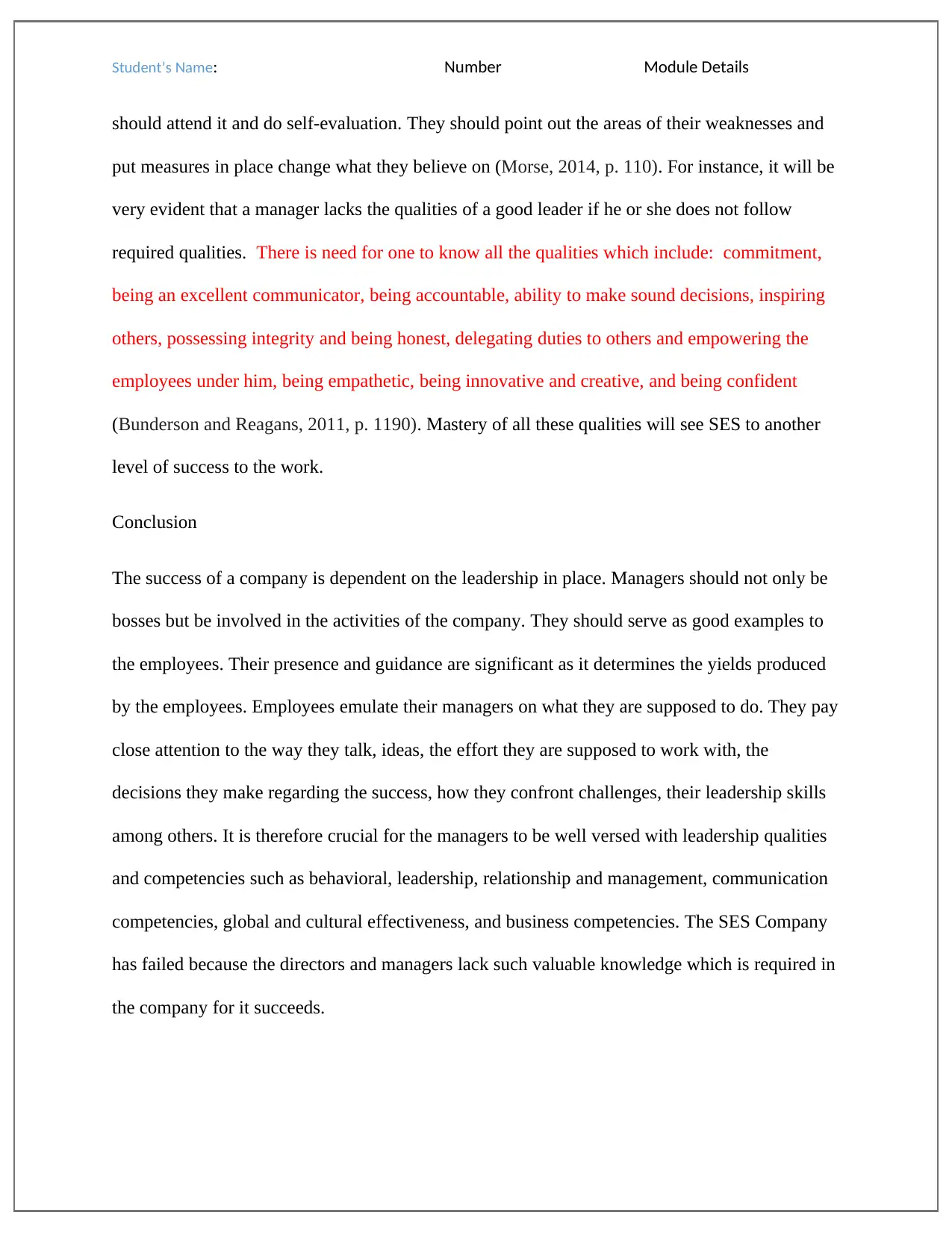
Student’s Name: Number Module Details
should attend it and do self-evaluation. They should point out the areas of their weaknesses and
put measures in place change what they believe on (Morse, 2014, p. 110). For instance, it will be
very evident that a manager lacks the qualities of a good leader if he or she does not follow
required qualities. There is need for one to know all the qualities which include: commitment,
being an excellent communicator, being accountable, ability to make sound decisions, inspiring
others, possessing integrity and being honest, delegating duties to others and empowering the
employees under him, being empathetic, being innovative and creative, and being confident
(Bunderson and Reagans, 2011, p. 1190). Mastery of all these qualities will see SES to another
level of success to the work.
Conclusion
The success of a company is dependent on the leadership in place. Managers should not only be
bosses but be involved in the activities of the company. They should serve as good examples to
the employees. Their presence and guidance are significant as it determines the yields produced
by the employees. Employees emulate their managers on what they are supposed to do. They pay
close attention to the way they talk, ideas, the effort they are supposed to work with, the
decisions they make regarding the success, how they confront challenges, their leadership skills
among others. It is therefore crucial for the managers to be well versed with leadership qualities
and competencies such as behavioral, leadership, relationship and management, communication
competencies, global and cultural effectiveness, and business competencies. The SES Company
has failed because the directors and managers lack such valuable knowledge which is required in
the company for it succeeds.
should attend it and do self-evaluation. They should point out the areas of their weaknesses and
put measures in place change what they believe on (Morse, 2014, p. 110). For instance, it will be
very evident that a manager lacks the qualities of a good leader if he or she does not follow
required qualities. There is need for one to know all the qualities which include: commitment,
being an excellent communicator, being accountable, ability to make sound decisions, inspiring
others, possessing integrity and being honest, delegating duties to others and empowering the
employees under him, being empathetic, being innovative and creative, and being confident
(Bunderson and Reagans, 2011, p. 1190). Mastery of all these qualities will see SES to another
level of success to the work.
Conclusion
The success of a company is dependent on the leadership in place. Managers should not only be
bosses but be involved in the activities of the company. They should serve as good examples to
the employees. Their presence and guidance are significant as it determines the yields produced
by the employees. Employees emulate their managers on what they are supposed to do. They pay
close attention to the way they talk, ideas, the effort they are supposed to work with, the
decisions they make regarding the success, how they confront challenges, their leadership skills
among others. It is therefore crucial for the managers to be well versed with leadership qualities
and competencies such as behavioral, leadership, relationship and management, communication
competencies, global and cultural effectiveness, and business competencies. The SES Company
has failed because the directors and managers lack such valuable knowledge which is required in
the company for it succeeds.
Paraphrase This Document
Need a fresh take? Get an instant paraphrase of this document with our AI Paraphraser
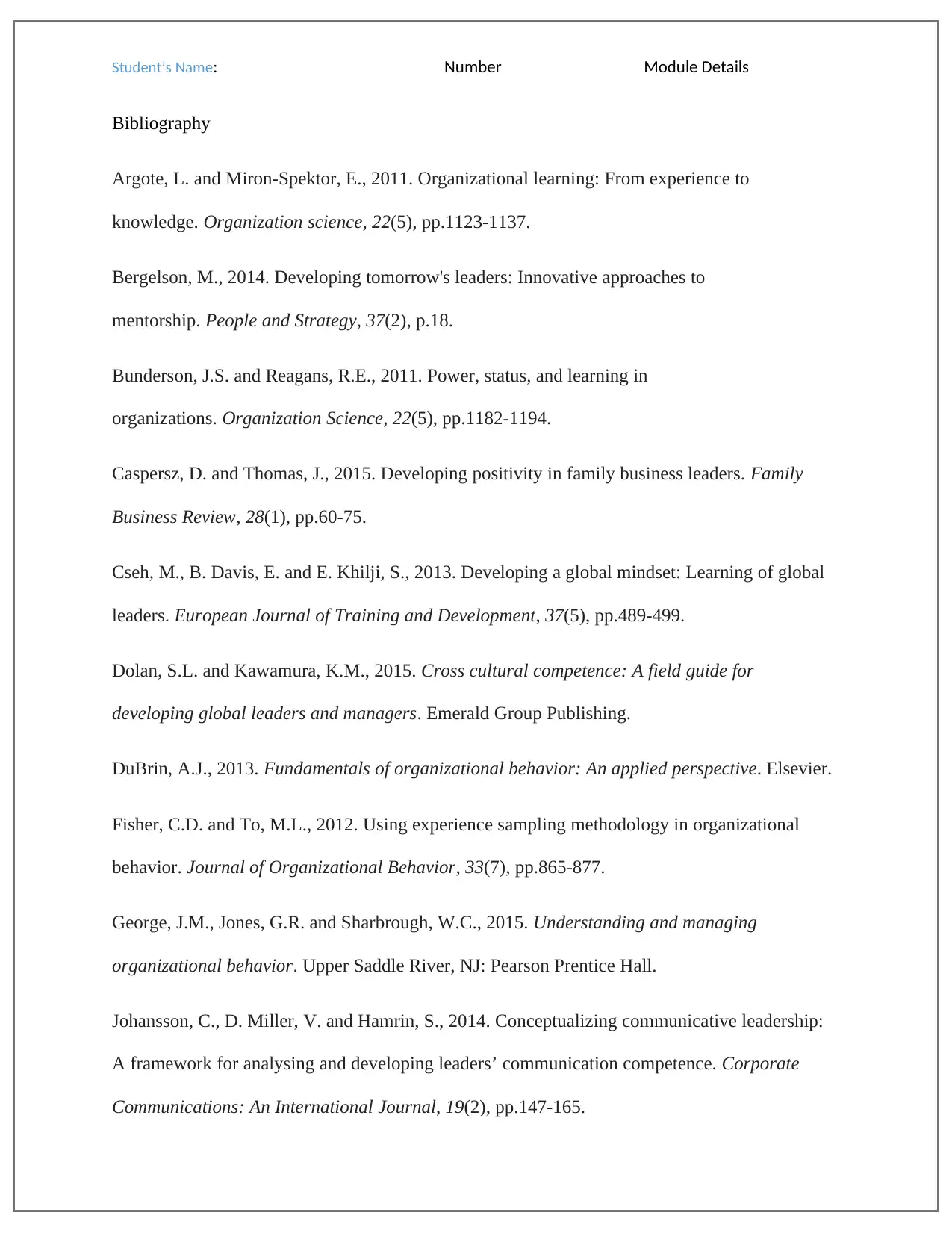
Student’s Name: Number Module Details
Bibliography
Argote, L. and Miron-Spektor, E., 2011. Organizational learning: From experience to
knowledge. Organization science, 22(5), pp.1123-1137.
Bergelson, M., 2014. Developing tomorrow's leaders: Innovative approaches to
mentorship. People and Strategy, 37(2), p.18.
Bunderson, J.S. and Reagans, R.E., 2011. Power, status, and learning in
organizations. Organization Science, 22(5), pp.1182-1194.
Caspersz, D. and Thomas, J., 2015. Developing positivity in family business leaders. Family
Business Review, 28(1), pp.60-75.
Cseh, M., B. Davis, E. and E. Khilji, S., 2013. Developing a global mindset: Learning of global
leaders. European Journal of Training and Development, 37(5), pp.489-499.
Dolan, S.L. and Kawamura, K.M., 2015. Cross cultural competence: A field guide for
developing global leaders and managers. Emerald Group Publishing.
DuBrin, A.J., 2013. Fundamentals of organizational behavior: An applied perspective. Elsevier.
Fisher, C.D. and To, M.L., 2012. Using experience sampling methodology in organizational
behavior. Journal of Organizational Behavior, 33(7), pp.865-877.
George, J.M., Jones, G.R. and Sharbrough, W.C., 2015. Understanding and managing
organizational behavior. Upper Saddle River, NJ: Pearson Prentice Hall.
Johansson, C., D. Miller, V. and Hamrin, S., 2014. Conceptualizing communicative leadership:
A framework for analysing and developing leaders’ communication competence. Corporate
Communications: An International Journal, 19(2), pp.147-165.
Bibliography
Argote, L. and Miron-Spektor, E., 2011. Organizational learning: From experience to
knowledge. Organization science, 22(5), pp.1123-1137.
Bergelson, M., 2014. Developing tomorrow's leaders: Innovative approaches to
mentorship. People and Strategy, 37(2), p.18.
Bunderson, J.S. and Reagans, R.E., 2011. Power, status, and learning in
organizations. Organization Science, 22(5), pp.1182-1194.
Caspersz, D. and Thomas, J., 2015. Developing positivity in family business leaders. Family
Business Review, 28(1), pp.60-75.
Cseh, M., B. Davis, E. and E. Khilji, S., 2013. Developing a global mindset: Learning of global
leaders. European Journal of Training and Development, 37(5), pp.489-499.
Dolan, S.L. and Kawamura, K.M., 2015. Cross cultural competence: A field guide for
developing global leaders and managers. Emerald Group Publishing.
DuBrin, A.J., 2013. Fundamentals of organizational behavior: An applied perspective. Elsevier.
Fisher, C.D. and To, M.L., 2012. Using experience sampling methodology in organizational
behavior. Journal of Organizational Behavior, 33(7), pp.865-877.
George, J.M., Jones, G.R. and Sharbrough, W.C., 2015. Understanding and managing
organizational behavior. Upper Saddle River, NJ: Pearson Prentice Hall.
Johansson, C., D. Miller, V. and Hamrin, S., 2014. Conceptualizing communicative leadership:
A framework for analysing and developing leaders’ communication competence. Corporate
Communications: An International Journal, 19(2), pp.147-165.
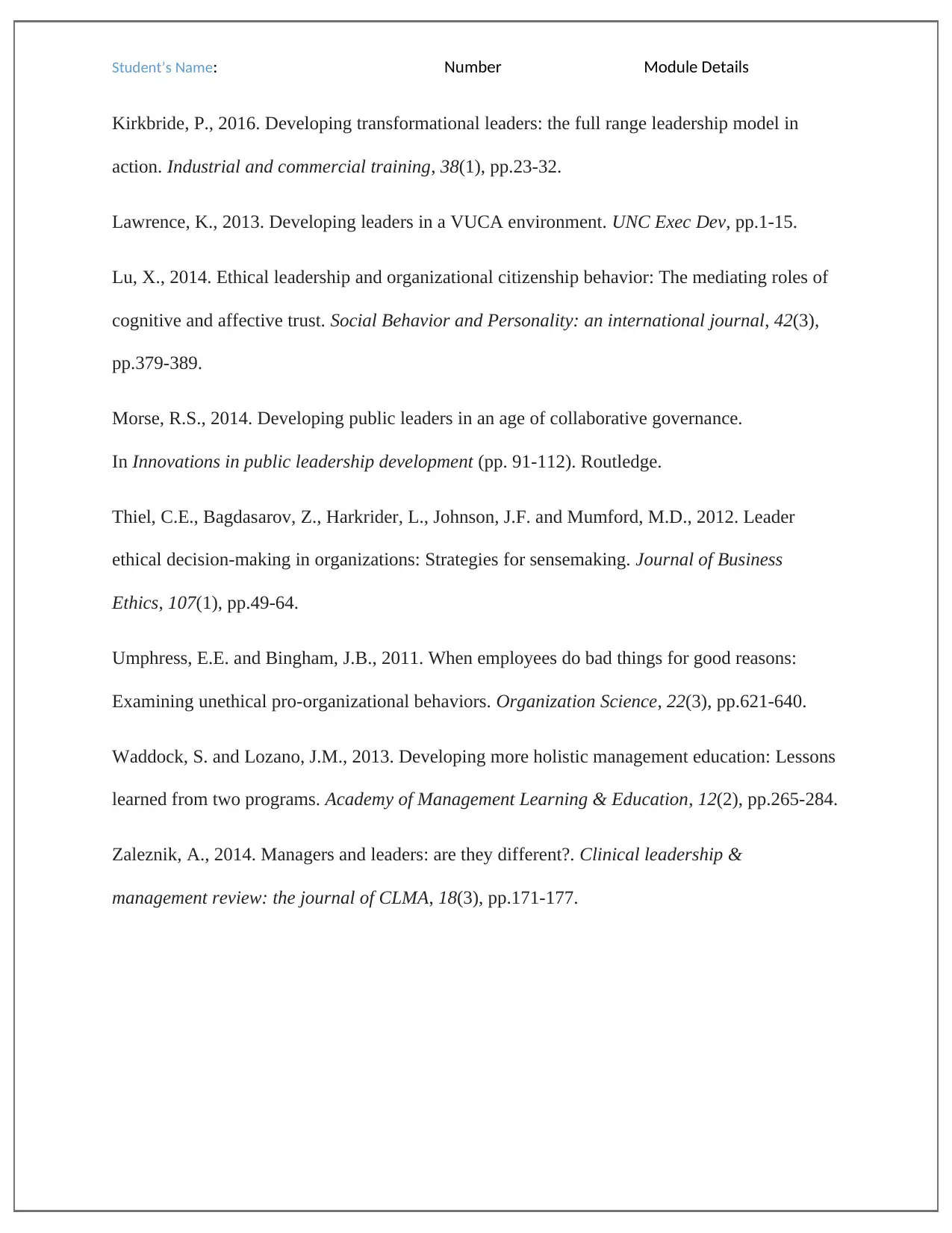
Student’s Name: Number Module Details
Kirkbride, P., 2016. Developing transformational leaders: the full range leadership model in
action. Industrial and commercial training, 38(1), pp.23-32.
Lawrence, K., 2013. Developing leaders in a VUCA environment. UNC Exec Dev, pp.1-15.
Lu, X., 2014. Ethical leadership and organizational citizenship behavior: The mediating roles of
cognitive and affective trust. Social Behavior and Personality: an international journal, 42(3),
pp.379-389.
Morse, R.S., 2014. Developing public leaders in an age of collaborative governance.
In Innovations in public leadership development (pp. 91-112). Routledge.
Thiel, C.E., Bagdasarov, Z., Harkrider, L., Johnson, J.F. and Mumford, M.D., 2012. Leader
ethical decision-making in organizations: Strategies for sensemaking. Journal of Business
Ethics, 107(1), pp.49-64.
Umphress, E.E. and Bingham, J.B., 2011. When employees do bad things for good reasons:
Examining unethical pro-organizational behaviors. Organization Science, 22(3), pp.621-640.
Waddock, S. and Lozano, J.M., 2013. Developing more holistic management education: Lessons
learned from two programs. Academy of Management Learning & Education, 12(2), pp.265-284.
Zaleznik, A., 2014. Managers and leaders: are they different?. Clinical leadership &
management review: the journal of CLMA, 18(3), pp.171-177.
Kirkbride, P., 2016. Developing transformational leaders: the full range leadership model in
action. Industrial and commercial training, 38(1), pp.23-32.
Lawrence, K., 2013. Developing leaders in a VUCA environment. UNC Exec Dev, pp.1-15.
Lu, X., 2014. Ethical leadership and organizational citizenship behavior: The mediating roles of
cognitive and affective trust. Social Behavior and Personality: an international journal, 42(3),
pp.379-389.
Morse, R.S., 2014. Developing public leaders in an age of collaborative governance.
In Innovations in public leadership development (pp. 91-112). Routledge.
Thiel, C.E., Bagdasarov, Z., Harkrider, L., Johnson, J.F. and Mumford, M.D., 2012. Leader
ethical decision-making in organizations: Strategies for sensemaking. Journal of Business
Ethics, 107(1), pp.49-64.
Umphress, E.E. and Bingham, J.B., 2011. When employees do bad things for good reasons:
Examining unethical pro-organizational behaviors. Organization Science, 22(3), pp.621-640.
Waddock, S. and Lozano, J.M., 2013. Developing more holistic management education: Lessons
learned from two programs. Academy of Management Learning & Education, 12(2), pp.265-284.
Zaleznik, A., 2014. Managers and leaders: are they different?. Clinical leadership &
management review: the journal of CLMA, 18(3), pp.171-177.
⊘ This is a preview!⊘
Do you want full access?
Subscribe today to unlock all pages.

Trusted by 1+ million students worldwide
1 out of 9
Related Documents
Your All-in-One AI-Powered Toolkit for Academic Success.
+13062052269
info@desklib.com
Available 24*7 on WhatsApp / Email
![[object Object]](/_next/static/media/star-bottom.7253800d.svg)
Unlock your academic potential
Copyright © 2020–2025 A2Z Services. All Rights Reserved. Developed and managed by ZUCOL.





